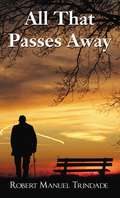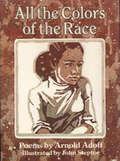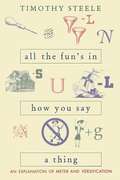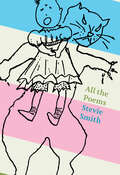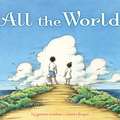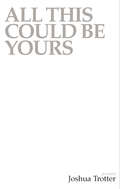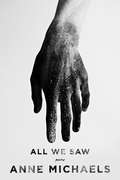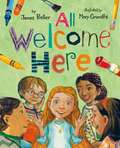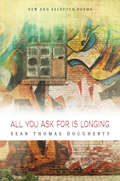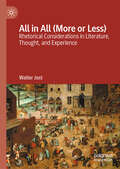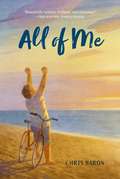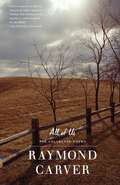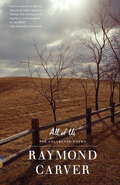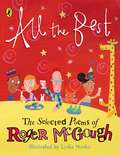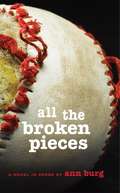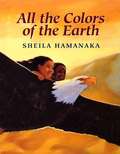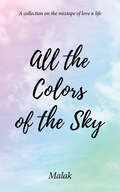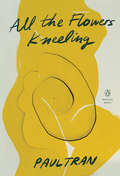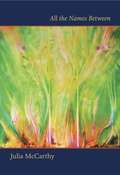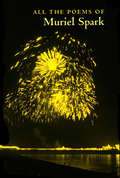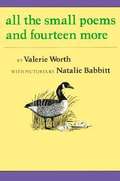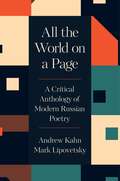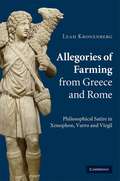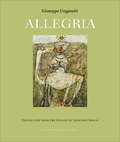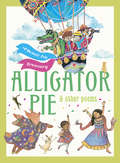- Table View
- List View
All That Passes Away
by Robert Manuel TrindadeWith feeble life that's all too brief, there is a hope to bring relief. Beyond the sights within our view will be a life created new. Although we leave a grave to tend, there is a life without an end.For one day God will recreate the heavens and the earth, and there's a life eternal with our spirit's saving birth. Not just the earth, but all of nature God will recreate. God starts within, but there is more; for that we'll have to wait.
All The Colors Of The Race
by Arnold Adoff John L. SteptoeA collection of poems written from the point of view of a child with a black mother and a white father.
All The Fun's In How You Say A Thing: An Explanation Of Meter And Versification
by Timothy SteelePerfect for the general reader of poetry, students and teachers of literature, and aspiring poets, All the Fun’s in How You Say a Thing is a lively and comprehensive study of versification by one of our best contemporary practitioners of traditional poetic forms. Emphasizing both the coherence and the diversity of English metrical practice from Chaucer’s time to ours, Timothy Steele explains how poets harmonize the fixed units of meter with the variable flow of idiomatic speech. He examines the ways in which poets have used meter, rhyme, and stanza to communicate and enhance meaning. Steele illuminates as well many practical, theoretical, and historical issues in English prosody, without ever losing sight of the fundamental pleasures, beauties, and insights that fine poems offer us. Written lucidly, with a generous selection of helpful scansions and explanations of the metrical effects of the great poets of the English language, All the Fun’s in How You Say a Thing is not only a valuable handbook on technique; it is also a wide-ranging study of English verse and a mine of entertaining information for anyone wishing more fully to write, enjoy, understand, or teach poetry.
All The Poems: Stevie Smith
by Stevie Smith Will MayThe essential edition of one of modern poetry’s most distinctive voices Stevie Smith is among the most popular British poets of the twentieth century. Her poem “Not Waving but Drowning” has been widely anthologized, and her life was celebrated in the classic 1978 movie Stevie. This new and updated edition of Stevie Smith’s collected poems includes hundreds of works from her thirty-five-year career. The Smith scholar Will May collects poems and illustrations from published volumes, provides fascinating details about their provenance, and describes the various versions Smith presented. Satirical, mischievous, teasing, disarming, Smith’s poems take readers from comedy to tragedy and back again, while her line drawings are by turns unsettling and beguiling.
All The World
by Liz Garton ScanlonFollowing a circle of family and friends through the course of a day from morning till night, this book affirms the importance of all things great and small in our world, from the tiniest shell on the beach, to warm family connections, to the widest sunset sky. Ages 3-7 All the world is here. It is there. It is everywhere. All the world is right where you are. Now.
All This Could Be Yours
by Joshua TrotterLike the promise of its title, All This Could Be Yours is full of elusive gifts. Joshua Trotter's debut collection is a metaphysical hall of windows that seem to be mirrors and mirrors presenting themselves as windows.
All We Saw
by Anne MichaelsFrom the internationally celebrated author of Fugitive Pieces and the Griffin Poetry Prize-shortlisted collection Correspondences -- and Toronto's Poet Laureate -- comes a profoundly moving new collection of poetry of love and memory.In All We Saw, Anne Michaels returns to poetry with strikingly original lyrics to explore one of her essential concerns: "what love makes us capable of, and incapable of." In this passionate, piercing short collection, dedicated to the late Mark Strand, Michaels explores "love's dare / love's repair / a single stitch." In lyrics that ponder what happens to the bodies of lovers -- so vital when together, different when apart, death coming to one before the other -- she embraces both the intimacy and the vastness of the connection between two people. The complete and sheltering understanding of a great love is a powerful presence in all the poems, with its particular imagery (the ringing fog, the white page of the bed), as is the shattering loss of its end. Lyrics of various forms and two longer poems explore desire in a style chaste, spare, figuratively modulated, calm and almost classical in its precision. By the book's end, we are left with a renewed awareness of the mystery at the core of our astonishing lives. With Michaels, we enter a space that is "not inside / nor outside: dusk's / doorway," where memory might be kept alive.
All Welcome Here
by James PrellerWith gorgeous multimedia paintings-and-collages by acclaimed artist Mary GrandPre, James Preller's All Welcome Here promises to be an evergreen gift picture book for children about to take the big leap into their first days of school.The bus door swishesOpen, an invitation.Someone is not sure . . .The first day of school and all its excitement, challenges, and yes, anxieties, are celebrated here in connected haiku poems. A diverse cast of characters all start—and finish—their first days of school, and have experiences that all children will relate to.
All You Ask For is Longing: New and Selected Poems (American Poets Continuum)
by Sean Thomas DoughertyFor over twenty years Sean Thomas Dougherty has negotiated between modernist and avant-garde writing and more populist traditions that extend back to Walt Whitman. His subject matter ranges from basketball to Bjork, from blue collar workers to Biggie Smalls, from Luciano Pavarotti to women waiting at a diner outside a prison in Upstate New York. Selecting from the best of eight previous collections, this New and Selected reveals the powerful arc and development of Dougherty's writing and establishes him as a voice of dissent for the future.A former Fulbright fellow, Sean Thomas Dougherty works at Gold Crown Billiards in Erie, Pennsylvania.
All in All (More or Less): Rhetorical Considerations in Literature, Thought, and Experience
by Walter JostThis book reinvents aspects of the rhetorical tradition as part of a philosophical pluralism oriented to “All-in-Allness”. Its chapters unfold some of the ethical and intellectual responsibilities philosophy and rhetoric share, their commitments toward literature broadly conceived, the limited authority of their interpretations, and the kinds of judgments they issue in. Part One, drawing chiefly on Ludwig Wittgenstein and Richard McKeon, leverages a central line of argument regarding “Rationality” in the pragmatism of Robert Brandom. Part Two pivots to specific instances of the range of rhetorical argument found in surprising places and in sophisticated arrangements. The book as a whole culminates in Part Three, where the author demonstrates how “ordinary language criticism” fruitfully bears on cultural models – film, drama, novels, poetry – belonging to “American Low Modernism.”
All of Me
by Chris Baron"Beautifully written, brilliant, and necessary." --Matt de la Pena, Newbery MedalistAri has body-image issues. After a move across the country, his parents work selling and promoting his mother's paintings and sculptures. Ari's bohemian mother needs space to create, and his father is gone for long stretches of time on "sales" trips. Meanwhile, Ari makes new friends: Pick, the gamer; the artsy Jorge, and the troubled Lisa. He is also relentlessly bullied because he's overweight, but he can't tell his parents—they're simply not around enough to listen.After an upsetting incident, Ari's mom suggests he go on a diet, and she gives him a book to help. But the book—and the diet—can’t fix everything. As Ari faces the demise of his parents' marriage, he also feels himself changing, both emotionally and physically. Here is a much-needed story about accepting the imperfect in oneself and in life.
All of Us: The Collected Poems
by Raymond Carver"Carver's poetry is like an almost invisible strand of fishing line reeling us all together, connecting us by the heart." --San Francisco Examiner and Chronicle. This prodigiously rich collection suggests that Raymond Carver was not only America's finest writer of short fiction, but also one of its most large-hearted and affecting poets. Like Carver's stories, the more than 300 poems in All of Us are marked by a keen attention to the physical world; an uncanny ability to compress vast feeling into discreet moments; a voice of conversational intimacy, and an unstinting sympathy. This complete edition brings together all the poems of Carver's five previous books, from Fires to the posthumously published No Heroics, Please. It also contains bibliographical and textual notes on individual poems; a chronology of Carver's life and work; and a moving introduction by Carver's widow, the poet Tess Gallagher.
All of Us: The Collected Poems (Vintage Contemporaries)
by Raymond CarverThis prodigiously rich collection suggests that Raymond Carver was not only America&’s finest writer of short fiction, but also one of its most large-hearted and affecting poets. Like Carver&’s stories, the more than 300 poems in All of Us are marked by a keen attention to the physical world; an uncanny ability to compress vast feeling into discreet moments; a voice of conversational intimacy, and an unstinting sympathy. This complete edition brings together all the poems of Carver&’s five previous books, from Fires to the posthumously published No Heroics, Please. It also contains bibliographical and textual notes on individual poems; a chronology of Carver&’s life and work; and a moving introduction by Carver&’s widow, the poet Tess Gallagher.
All the Best: The Selected Poems of Roger McGough
by Roger McGoughA wonderful selection of over 100 of Roger's own best-loved poems from his vast Puffin catalogue of poetry collections. Lots of favourites and some lesser known surprises, too. Packed with fabulous Lydia Monks illustrations throughout.
All the Broken Pieces: A Novel in Verse
by Ann E. BurgTwo years after being airlifted out of Vietnam in 1975, Matt Pin is haunted by the terrible secret he left behind, and now, in a loving adoptive home in the United States, a series of profound events forces him to confront his past.
All the Colors of the Earth
by Sheila HamanakaWith soaring words and majestic artwork, Sheila Hamanaka evokes all the rich colors children bring to this world. Laughing, loving, and glowing with life, young people dance across the pages of her book, inviting readers to share a special vision of peace and acceptance. Images removed.
All the Colors of the Sky: A collection on the mixtape of love & life
by MalakLike the ever-changing sky, our emotions are a vivid spectrum. From joy to sorrow, from youth to age, from dawn to dusk and the moments in between – our feelings paint a canvas as varied as the sky itself. We feel the warmth of love, the chill of indifference, the solitude of loneliness, and the comfort of companionship. From fiery reds to calming blues, vibrant orchids to muted lavenders, we embody every hue and shade. We are the brilliant sunrise, the melancholic sunset, and the mysterious twilight. All the Colors of the Sky is a collection that captures the essence of love and life, weaving tales that transcend the obvious, delving deep into the unseen emotions and untold stories. Experience the vastness, the beauty, the depth. Experience All the Colors of the Sky.
All the Flowers Kneeling (Penguin Poets)
by Paul Tran&“Paul Tran&’s debut collection of poems is indelible, this remarkable voice transforming itself as you read, eventually transforming you.&” —Alexander Chee, author of How to Write an Autobiographical Novel &“A stunning debut.&” —Natasha Trethewey, Pulitzer Prize-winning poet and author of Memorial Drive A profound meditation on physical, emotional, and psychological transformation in the aftermath of imperial violence and interpersonal abuse, from a poet both &“tender and unflinching&” (Khadijah Queen)Visceral and astonishing, Paul Tran's debut poetry collection All the Flowers Kneeling investigates intergenerational trauma, sexual violence, and U.S. imperialism in order to radically alter our understanding of freedom, power, and control. In poems of desire, gender, bodies, legacies, and imagined futures, Tran&’s poems elucidate the complex and harrowing processes of reckoning and recovery, enhanced by innovative poetic forms that mirror the nonlinear emotional and psychological experiences of trauma survivors. At once grand and intimate, commanding and deeply vulnerable, All the Flowers Kneeling revels in rediscovering and reconfiguring the self, and ultimately becomes an essential testament to the human capacity for resilience, endurance, and love.
All the Names Between
by Julie McCarthyPoems that form an eloquent, searching contemplation of “the warp and weft of being and nonbeing.” All the Names Between is Nova Scotia poet Julia McCarthy’s meditative and crackling-with-dark-energy third collection. From her observation of “long-horned beetles... rearranging the landscape” to an apperception of “part of me /...seeded by dust / of meteors and asteroids,” McCarthy makes palpable, in richly layered imagery and with attentiveness that unfolds stillness, the “Singing Emptiness” that informs and quickens the crow’s flight, the stones’ weight, and our own being as we move in “the defined world both elegant / and maimed.” Concerned with both the inadequacy and the necessity of word to convey world, the poems move through a shifting landscape of seasons and creatures, of the remembered dead, and of scattered stones reading the Akashic field. Grounded in the experience of presence, where the external and internal meet, a crossroads of consciousness where “a language without a name / remembers us” and the poem is a votive act, All the Names Between reflects the shadow-light of being, of what is and what isn’t, the seen and the unseen, the forgotten and the remembered where every elegy has an ode at its centreevery ode has an elegy around its edges. (from “Ode with an Elegy around its Edges”) Praise for All the Names Between: “It is Julia McCarthy’s incomparable eloquence as a poet to, as an experienced photographer might, wield darkness as an ever more powerful lens to reveal the intricate beauty of the world as she finds it. And it is with this extraordinary vision, that McCarthy ushers us into her newest collection, All the Names Between, ‘where the dead gather like trees in their white coats’ and bats hover overhead, ‘lucifugal as ashes from invisible fires.’ These are poems scintillate with vision and stunningly intimate—showing us page after page the full, and exquisite measure of ‘night’s worth.’” —Clarise Foster, Editor, Contemporary Verse 2 “Here is a book of meditations for even those immune to poetry, a poetry with no comfort zones. McCarthy takes readers to a world where the marriage between solitude and nature gives birth to memorable, haunting lines, where the mystery of poetry lies just between the words. I have no doubt readers will embrace this book as their own.” —Goran Simić, author of Immigrant Blues and From Sarajevo, with Sorrow
All the Poems of Muriel Spark
by Muriel SparkAvailable at last are all the poems by one of the twentieth century's greatest British writers, Dame Muriel Spark: "a true literary artist, acerbic and exhilarating" (London Evening Standard). In the seventy-three poems collected here Muriel Spark works in open forms as well as villanelles, rondels, epigrams, and even the tour de force of a twenty-one page ballad. She also shows herself a master of unforgettable short poems. Before attaining fame as a novelist (Memento Mori, The Prime of Miss Jean Brodie), Muriel Spark was already an acclaimed poet. The "power and control" of her poetry, as Publishers Weekly remarked, "is almost startling." With the vitality and wit typical of all her work, Dame Muriel has never stopped writing poems, which frequently appear in The New Yorker. As with all her creations, the poems show Spark to be "astonishingly talented and truly inimitable" (The San Francisco Chronicle).
All the Small Poems and Fourteen More
by Valerie WorthAll four Small Poems books in one volume plus fourteen new poems "every bit as worthy as their predecessors" (The Horn Book).
All the World on a Page: A Critical Anthology of Modern Russian Poetry
by Andrew Kahn Mark LipovetskyThe rich and ongoing development of Russian lyric poetry, explored through close readings of thirty-four poems by poets ranging from Alexander Blok to Maria StepanovaThe Russian cultural tradition treats poetry as the supreme artistic form, with Alexander Pushkin as its national hero. Modern Russian lyric poets, often on the right side of history but the wrong side of their country&’s politics, have engaged intensely with subjectivity, aesthetic movements, ideology (usually subversive), and literature itself. All the World on a Page gathers thirty-four poems, written between 1907 and 2022, presenting each poem in the original Russian and an English translation, accompanied by an essay that places the poem in its cultural, historical, and biographical contexts. The poems, both canonical and lesser-known works, extend across a range of moods and scenes: Velimir Khlebnikov&’s Futurist revolutionary prophecy, Anna Akhmatova&’s lyric cycle about poetic inspiration, Vladimir Nabokov&’s Symbolist erotic dreamworld, Joseph Brodsky&’s pastiche of a Chekhovian play set on a country estate, Maria Stepanova&’s pandemic allegory of political repression, Galina Rymbu&’s energetic manifesto &“My Vagina.&”An introduction explores the abiding inspiration of modernism on the Russian lyric tradition. Kahn and Lipovetsky's separate chapter essays, informed by extensive knowledge of the existing scholarship and critical styles of interpretation, consider how the interplay of originality and tradition and form and voice work to engage the reader. The poems themselves, many of them in newly commissioned translations, operate outside state-mandated poetic styles to address the reader directly, &“tête-à-tête,&” as Brodsky said in his 1987 Nobel lecture. With each chapter devoted to a different poem, All the World on a Page allows readers to experience the richness of Russian poetry through poems and poets rather than through movements.
Allegories of Farming from Greece and Rome
by Leah KronenbergIn this book Professor Kronenberg shows that Xenophon's Oeconomicus, Varro's De Re Rustica and Virgil's Georgics are not simply works on farming but belong to a tradition of philosophical satire which uses allegory and irony to question the meaning of morality. These works metaphorically connect farming and its related arts to political life; but instead of presenting farming in its traditional guise as a positive symbol, they use it to model the deficiencies of the active life, which in turn is juxtaposed to a preferred contemplative way of life. Although these three texts are not usually treated together, this book convincingly connects them with an original and provocative interpretation of their allegorical use of farming. It also fills an important gap in our understanding of the literary influences on the Georgics by showing that it is shaped not just by its poetic predecessors but by philosophical dialogue.
Allegria
by Giuseppe UngarettiGeoffrey Brock, whose translations have won him Poetry magazine's John Frederick Nims Memorial Prize and a Guggenheim Fellowship, finally does justice to these slim, concentrated verses in his English translation, alongside Ungaretti's Italian originals.Famed for his brevity, Giuseppe Ungaretti's early poems swing nimbly from the coarse matter of tram wires, alleyways, quails in bushes, and hotel landladies to the mystic shiver of pure abstraction. These are the kinds of poems that, through their numinous clarity and shifting intimations, can make a poetry-lover of the most stone-faced non-believer. Ungaretti won multiple prizes for his poetry, including the 1970 Neustadt International Prize for Literature. He was a major proponent of the Hermetic style, which proposed a poetry in which the sounds of words were of equal import to their meanings. This auditory awareness echoes through Brock's hair-raising translations, where a man holding vigil with his dead, open-mouthed comrade, says, "I have never felt / so fastened / to life."
Alligator Pie and Other Poems: A Dennis Lee Treasury
by Dennis Lee Juan WijngaardThree classic Dennis Lee titles in one beautiful book This giftable and shareable volume brings together three of Dennis Lee’s best-loved collections of poetry—Alligator Pie, Jelly Belly and The Ice Cream Store—spanning three decades of his warm and whimsical rhymes. “You can almost hear the skipping rope slapping the sidewalk,” wrote Margaret Laurence of Dennis Lee’s timeless poetry collection Alligator Pie. One of the first published illustrated books about Canadian children, and featuring Frank Newfeld’s instantly recognizable original illustrations, Alligator Pie has sold more than half a million copies since its publication in 1974. Originally published in 1983, Jelly Belly tickles readers with a mix of humour and traditional Mother Goose charm. The vivid illustrations by Juan Wijngaard (winner of the 1981 Mother Goose Award) reveal wonders as readers follow the characters throughout the book and stumble upon new and fascinating visual treasures. In the kid-pleasing collection The Ice Cream Store, originally published in 1991, Dennis Lee delves into the special and imaginative world of children. David McPhail’s gorgeous and appealing watercolour paintings of children and animals portray both the familiar and the fantastic, extending the meaning of the poems and providing a colourful feast for the eye.
